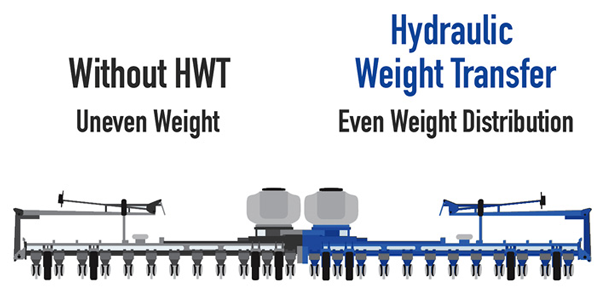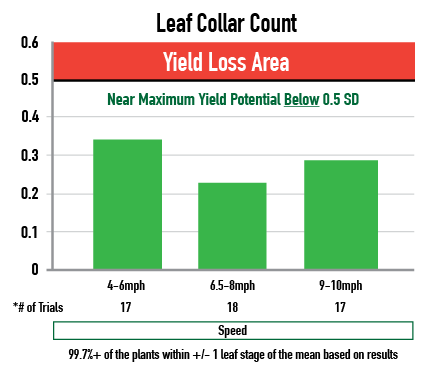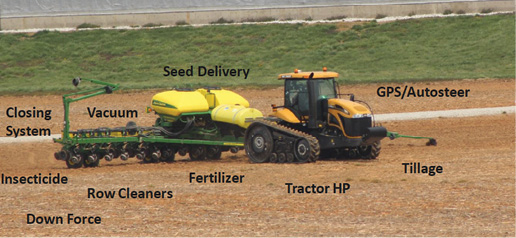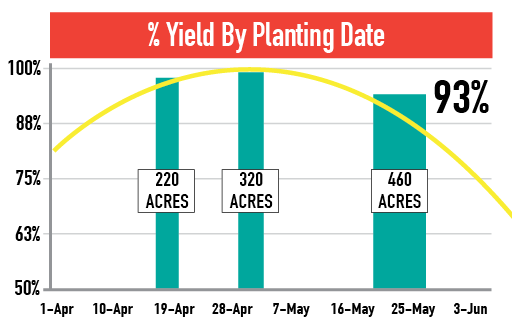Just over a year ago, John Deere raised the eyebrows of many in the industry with the announcement that the traditional barriers of planting speed and accuracy could be broken. At the 2014 National Farm Machinery Show, the manufacturer unveiled its ExactEmerge row unit system that claimed to provide accurate seed placement at 10 mph.
With yields so dependent on the narrow planting window determined by Mother Nature, the ability for farmers to better control their destiny, and calendar, was an exciting development.
Now that a year has passed, and with trials that provided data on high-speed planting, Farm Industry News attracted a crowd with the high-speed planting seminar it hosted at this year’s National Farm Machinery Show. In addition to John Deere, representatives from Kinze, Horsch and Precision Planting also presented what they are offering to their dealers and growers in high-speed technologies.
A plethora of challenges exist with planting at almost twice the traditional speeds, and each manufacturer has a unique view of how to address these through design changes and innovation.
Kinze Manufacturing
The high-speed 4900 series planter available from Kinze Manufacturing can plant up to 8 mph, a 2.5 mph increase over its traditional planter (3000 series). A main feature of this planter series is a standard hydraulic weight transfer system designed to increase seed and fertilizer carrying capacity that minimizes the number of times the planter needs to be filled each day, ultimately increasing the field efficiency.
Traditional planters tend to have most of the weight above the center section, which can create inconsistent depth placement with the planter wings. Kinze District Sales Manager Chris Schlesser says, “If the center section is sinking in, you aren’t going to be keeping consistent depth from left to right across the toolbar. You’re also creating pinched row compaction, which is deterring yield potential.

Kinze’s hydraulic weight transfer evenly spreads the weight to control compaction. With the hydraulic weight transfer, farmers can reduce weight on the center to 2,250 pounds vs. 6,000 pounds on a standard bulk-fill planter.
“We view the challenge as not just being able to go faster, but being more efficient, utilizing bulk fill and fertilizer capacities to reduce the frequency of fill-ups while increasing speed. Consider 6,000 pounds on the center part of a standard bulk fill planter; all the weight is on the middle portion. Compare that to our hydraulic weight transfer system; only about 2,250 pounds is the effective weight on the center section of the toolbar.”
There are additional benefits to distributing the weight of the seed and fertilizer across the toolbar. Schlesser says the danger of compaction is very real to yields. “It’s going to be reducing the oxygen levels in the soil, which can affect the crop. It’s also reducing the water-carrying capacity of the soil and it’s certainly restricting the root growth potential of those pinched rows.” He cites research from Becks Hybrids that shows an 11 bushel yield reduction without hydraulic weight transfer.
Schlesser also touts Kinze’s simplicity, from the electric drives at each row that eliminate working parts to the ISOBUS monitoring. “With single seed disc selections for corn, soybeans and other crops, farmers don’t have to switch discs out based on seed size or shape.”
Fertilizer openers for 4900 planters allow adjustable down pressure and fertilizer openers can be locked out of the ground in the “up” position without tools, vs. having to spend extra time taking them off. The process of switching from soybeans to corn is streamlined, which allows for covering more acres. All of the meters on the planter use an electrically driven vacuum system. It has a narrow road transport width with front folding frame, available in 12, 16 and 24 rows with 30-inch spacing.
A Year Later: John Deere Reports on Last Spring’s High Speed Planter Use
John Deere provided its ExactEmerge technology for farmers’ use last year, with 36 planters seeding more than 75,000 acres. With it commercially available for the first time this spring, Deere’s Kelby Krueger provided an update on the experience of farmers (averaging 8.8 mph) last year and data that he says show that spacing and emergence were not adversely affected by operating at higher speeds.
His presentation included two slides on seed spacing and emergence, pictured below.
On the first slide on space, he says, the graph shows that speed is the limiting factor only as the CV exceeds 0.33. “As they went faster, the spacing was not affected with that increase in speed to deliver that maximum yield potential.”
In discussing emergence and the importance of getting the seed in the trench closed up and coming up at the same time, he shared a slide charting emergence at speeds of 4-10 mph. He says it shows that if the farm had a standard deviation on leaf collars of less than 0.5, maximum yield potential was found. “So as we increase speed, it didn’t affect emergence.”
He concluded by saying that seed placement accuracy and speeds are not an either/or question. “When people choose to do the seed placement accuracy first, they’ll sacrifice going faster because of what you will lose to get those acres in. You need that seed placement accuracy and you need to be able to do it faster so you can get more done during that optimum planting window.”


Schlesser also talked of the 4900 multi-hybrid capability that’s available this spring, and shared additional research from Becks that showed a 1,000-acre farmer could show a 9.5 bushel yield advantage and put another $33,500 in their pocket.
Horsch
With a fresh view of high-speed challenges, Horsch, a newcomer in the North American planter market (began marketing its Maestro here in 2012), has a relatively long history in Europe. Horsch’s design philosophy considers ground speed as only one component of productivity and Horsch engineers have integrated multiple efficiencies when designing a planter from the ground up. Since 2012, Horsch has produced 11,000 of the Maestro row units worldwide, and the company says it’s a widely accepted platform that is working for farmers.
As planter speeds rise, the potential for major component failures increase exponentially and Horsch has added bulk to compensate. Product Manager Drew Gerber says, “Our row unit weighs over 550 pounds, because as we’re increasing ground speed, we’re going to change the force applied to the planter. The row unit, the toolbar, everything, has to be built in order to handle those increased stresses.”
To add rigidity, the Horsch row unit parallel arms are unique in that they actually have two laser-cut tubes that interlock with each other in the front and rear. The mainframe is a half-inch tube; hinged portions, or flex points on the toolbar itself, are reinforced with 1.25-inch steel.
“It’s important to keep that in mind because as you’re going faster, the hinge point is an area that is going to experience additional stress,” Gerber says. “So we’ve reinforced it to be able to maintain and add life to planters at these higher speeds.”
The Horsch philosophy is that there are other ways to get more acres covered in a day besides speeding up. Increasing seed and fertilizer capacities will limit downtime in the field, effectively increasing the number of acres covered. “The Horsch planter features hydraulic downforce for a smoother ride and is capable of just under 800 pounds of pressure on the row unit. With the increased capacities, we also utilize a weight transfer system that spreads the weight of the tanks across the toolbar to keep the row unit in the ground while going faster,” says Gerber.
“Because of the construction, the planter capacities have been expanded. On our 24-row planter, we have 1,000 gallons of liquid fertilizer on board and 140 bushels of seed. On our 40-foot toolbars, we have 83 bushels of seed and 770 gallons of liquid fertilizer capacity. On average, we’re going to spend 37% less time filling up than the competition. To plant the same number of acres in the time saved, competitors would have to drive a mile and a half faster throughout an entire 24-hour period and that’s strictly due to capacities”
Electric drives are employed in the Horsch planter, using tractor power, which adds to the simplicity of the machine’s design. Gerber says, “The reason that we’re able to utilize just the tractor power is because we use a small, stainless steel slotted disc, vacuum and a seed tube. With a rapidly spinning disc, if we just kill the vacuum as in a traditional manner, that seed is going to be subject to gravity and centrifugal forces from the circular movement.
“But the slotted disc, combined with a scraper, enables us to transition the grain to the outside of the disc and then we force it to go into the seed tube in the same position every time. What we’ve seen is that if you are more accurate going into the seed tube, it translates to more consistency coming out of the seed tube.”
Precision Planting
Taking a different view of successful high-speed seeding is Precision Planting, which manufactures components to upgrade multiple planter brands to its technology and recently announced a joint partnership with Case IH. With the agreement, some of their products will be offered as OEM options on Case IH planters.

Horsch added bulk to its Maestro planter to withstand the rigors of high-speed planting. The hinge (see inset) was engineered to handle additional stress.
Engineer Kent Levy says there’s a problem with increasing planting speeds due to row unit ride, bounce and speeds at the ground level. “As the seed comes out of the seed tube, it’s traveling horizontally rearward at about 3.5 mph. When planting faster, the difference between the speed of the seed travelling out of the tube and the ground speed becomes greater. So when the seed hits the furrow, it has a tendency to bounce and roll because of the speed differential.”
To address the issue, Precision Planting’s vSet meter has been coupled with its vDrive in a high-speed planting device. “The seed comes around a disc and is placed on a flighted belt,” Levy says. “The belt takes the seeds down to the bottom of the row unit while maintaining spacing. As they come around to the bottom, the seeds are placed into the ground. The system matches ground speed with the speed of the seed coming out, thereby eliminating bounce and roll, because the two are traveling at the same rate. By controlling the seed all the way from the meter to the furrow, the problems of high-speed planting have been eliminated.”
Levy breaks down the advantages of high-speed planting with a specific example from 2013, a wet planting season that made the peak-seeding window very brief across much of the Midwest.

High-speed planting is not just about the planter, says Precision Planting’s Kent Levy, citing the role that each of the components in this photo contribute to a total system.
“Fig. 1 shows a grower in Illinois with 1,000 acres, with the green line showing the historical averages on best planting dates for Illinois, Indiana and Iowa. The green line represents yield potential, so as you get later planting dates, you’re losing the maximum bushels that can be grown.
“Because of seasonal rains in 2013, this farmer could only plant about half of his acres in the ideal planting window. He was only able to realize about 93% of his yield potential, because he wasn’t able to get as much of his crop in the ground during the ideal planting window.
“In Fig. 2 we see that the same grower, with a high-speed planter, would have had a 1.5 times productivity gain, and could shift about 280 of those acres forward to the ideal planting window. In that scenario, he would realize about 98% of his yield potential. So if he was growing 180 bushels of corn, that 5% gain would have translated to an over $31,000 gain to his bottom line.”
Levy warns producers that the advantages of high speed planting are lost if row units don’t stay a consistent distance above the furrow, something that’s best accomplished by row-by-row hydraulic control. In addition to how soil dynamics change at 10 mph, he says a total system consideration is needed. At higher speeds, performance and wear on a lot of other components can be affected.

Fig. 1. This Illinois farmer realized only 93% of his yield potential because he planted just half of his acres in what history showed as the optimum planting window.

Fig 2. Using a high-speed planter, the same grower as in Fig. 1 could expect a productivity gain of 1.5 times and would likely have realized a 98% yield potential by getting his crop in during the ideal planting window.
John Deere
Also focusing on new methods of seed delivery, John Deere’s new ExactEmerge planter has claimed speeds as high as 10 mph. It uses a high-performance meter to singulate seeds before they’re sent to a new trench delivery system. These high-speed planters were run last spring in field demonstrations (36 planters in use over 75,000 acres) and now the finished product is in transit to dealers for the 2015 planting season.
John Deere Seeding Group Product Specialist Kelby Krueger says, “To get the increased seeds per second, we have a unique design where the seed puddle is in both the meter and a ‘bowl.’ The seed is pulled downward from the vacuum and gravity and after it gets singulated, it is crisply handed off to the trench delivery system. There the BrushBelt comes around a pulley, the bristles spread apart and the seed gets handed off. No extra mechanical help is needed, it is able to swipe it with the cross feed action of the bowl. Then as the bristles come back together, it firmly pinches the seed on all four sides for delivery to the trench.”
Deere engineers acknowledge that at higher speeds, row units are going to experience more dynamics. Krueger says, “But you want them to follow the profile of the ground, because if seed depth is set at 2 inches at 5 mph, the row unit’s going up and down when you increase ground speed; it’s going to move much faster. When the BrushBelt system is moving up and down, the seed to seed relationship is maintained. Seeds are perfectly spaced when coming off the bowl, because all the holes are exactly the same distance apart. We try to maintain that perfect spacing as close to the bottom of the trench as possible, which is 2 inches above the bottom of the trench.”

Key among John Deere’s advancements for meeting the many variables in high-speed planting is its trench-delivery system and BrushBelt technology.
Deere’s system utilizes two electric drive motors, one for the meter and one for the BrushBelt delivery system, which is driven essentially by radar. If the ground speed is 5 mph, the seeds will be moving rearward at 5 mph. If travel speed is increased to 10 mph, correspondingly, movement of the seed changes to 10 mph.
Speed is Terrain-Specific
In summary, each of the participants acknowledges the advantages of increasing the number of acres covered in the optimum seeding window. Kinze and Horsch use weight distribution systems to allow for more capacity, thereby increasing the time between stops to fill. Precision Planting and John Deere are using powered delivery systems to match ground and seed speeds to run faster in the field.
All admit that not every terrain can be a candidate for high-speed seeding and that almost doubling the speed of the planter will make it prone to repairs and possibly shorten machine lifespans. What it all boils down to for the producer is whether the increased yield will cover the higher cost of the beefier machines needed to go faster and the accompanying higher maintenance costs. That’s the question that can only begin to be answered as the new high-speed planters hit the field this spring.







